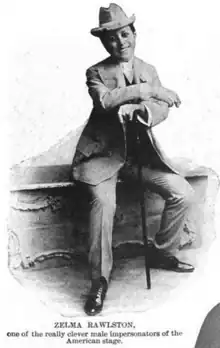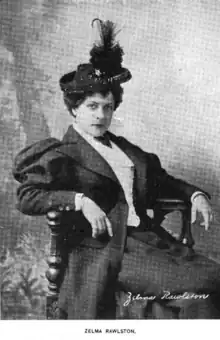Zelma Rawlston
Zelma Rawlston (died October 30, 1915) was an American singer, comedian, and vaudeville performer, specializing in male impersonation, born Zelma Stuchenholz in Germany. She was billed as the "American Vesta Tilley."


Early life
Zelma Stuchenholz was born in Germany and moved to the United States as a child.[1][2] One profile, however, described her as being born in New York City in 1873, and training as a singer with Eugenie Pappenheim and Adelina Murio Celli, before attending National Conservatory of Music of America on a scholarship.[3]
Career
Rawlston was a soprano singer with the Charles F. Higgins Concert Company, formed in 1888.[4] With her own touring company, she appeared in operatic, soubrette, and male roles, all on the same bill.[5] She was billed as "the American Vesta Tilley" because she dressed as a man for her vaudeville performances;[6] "for the first few years of her stage career she never appeared in anything but trousers," noted the New York Times in 1915.[7] However, at some appearances, she changed from female to male clothing quickly onstage.[8] In 1904, she explained that she cut her own hair short to improve the impersonation.[9] In 1905, she was touring with George Lederer's "Smiling Island" company.[10]
Rawlston originated the role of "Willie Van Astorbilt" in The Burgomaster (1900-1901) on Broadway. "Her singing of 'The Kangaroo Girl' has set the town to whistling the catchy air and made Miss Rawlston many friends," noted one New York paper.[11] Other Broadway appearances included The Earl and the Girl (1905-1906) with Eddie Foy,[12] and Chin-Chin (1914).[13] Based on her fame, Rawlston's name, likeness, and testimony were used to advertise "Pe-Ru-Na" (a patent medicine marketed to women)[14] and Dr. Bull's Cough Syrup.[15]
Her photograph appeared on sheet music of her most popular numbers.[16] She wrote the words to at least one published song, "We'll Take De Trip Dey Calls De Honeymoon" (1899).[17]
References
- "Miss Zelma Rawlston" New York Times (October 31, 1915): 17. via ProQuest
- "Report of the Public Administrator of the County of New York for the Year 1917" Proceedings of the Board of Aldermen (January 15, 1918): 84.
- "Theatrical Gossip" Attica Independent (July 10, 1896): 4. via Newspapers.com

- "Driftwood" The Theatre (September 7, 1889): 461.
- "Town Talk" The Tammany Times (June 3, 1901): 13.
- Lester Sweyd, "What they were Doing a Few Years Ago" Motion Picture (September 1915): 118.
- "Minute Visits in the Wing" New York Times (May 16, 1915): X5. via ProQuest
- Andrew L. Erdman, Blue Vaudeville: Sex, Morals, and the Mass Marketing of Amusemeent, 1895-1915 (McFarland 2007): 88. ISBN 9781476613291
- Untitled theatrical item, St. Louis Republic (July 31, 1904): 30. via Newspapers.com

- "Zelma Rawlston of 'Smiling Island'" Daily News-Democrat (March 30, 1905): 8. via Newspapers.com

- "Zera Rawlston's Hit" The Tammany Times (January 7, 1901): 3.
- "Eddie Foy at the Belasco" The Index (December 26, 1906): 14.
- "Globe: Chin-Chin" The Theatre (December 1914): 304.
- "Women Praise Pe-Ru-Na" Wichita Beacon (October 10, 1903): 2. via Newspapers.com

- "Miss Zelma Rawlston" Minneapolis Journal (November 1, 1901): 11. via Newspapers.com

- "Male impersonators in early 20th century American sheet music" Houghton Library Blog (February 19, 2016).
- Zelma Rawlston and Wm. B. Fairchild, "We'll Take De Trip Dey Calls De Honeymoon" Boston Globe (June 18, 1899): 40. via Newspapers.com

- "Zelma Rawlston Dead" Boston Globe (October 31, 1915): 8. via Newspapers.com

External links
- Sheet music and publicity materials featuring images of Zelma Rawlston, dated 1897 through 1903, from the Digital Transgender Archive.
- Zelma Rawlston, Billy Rose Theatre Collection Photograph File, New York Public Library Digital Collections.
- Zelma Rawlston, Majestic; Vaudeville Museum Archive.
- Zelma Rawlston in The Earl and the Girl; Vaudeville Museum Archive.
- Portrait of Zelma Rawlston, University of Illinois Theatrical Print Collection.
- Zelma Rawlston at the Internet Broadway Database